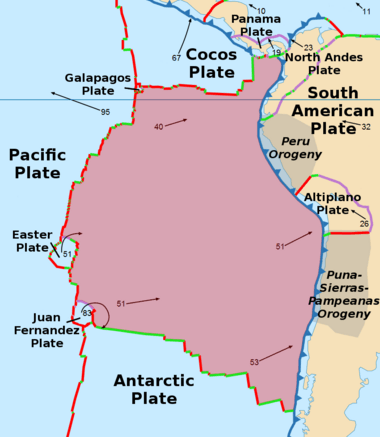Nazca Plate facts for kids
Quick facts for kids Nazca Plate |
|
|---|---|
 |
|
| Type | Minor |
| Approximate area | 15,600,000 km2 |
| Movement1 | north-east |
| Speed1 | 40-53 mm/year |
| Features | Pacific Ocean |
| 1Relative to the African Plate | |
The Nazca Plate is a large piece of the Earth's outer shell, called an oceanic tectonic plate. It is found in the eastern part of the Pacific Ocean.
This plate is named after the Nazca region in southern Peru. This area is located off the west coast of South America. The Nazca Plate is always moving, though very slowly.
Contents
What is the Nazca Plate?
The Earth's surface is made up of many huge pieces called tectonic plates. These plates are always moving, even if we can't feel it. The Nazca Plate is one of these plates. It is an "oceanic" plate because it is mostly under the ocean.
How the Nazca Plate Moves
The Nazca Plate is special because it is constantly sliding underneath the South American plate. This process is called subduction. Imagine one giant puzzle piece slowly slipping under another.
Creating Mountains and Volcanoes
When the Nazca Plate slides under the South American Plate, it causes a lot of pressure and heat. This process is the main reason why the huge Andean mountains formed in South America. This mountain-building process is known as orogeny. It also leads to many earthquakes and volcanoes in the region.
Hotspots and Islands
As the Nazca Plate moves, it passes over special spots deep within the Earth called hotspots. These are like fixed "plumes" of hot rock that melt through the plate above them.
Volcanic Islands and Seamounts
When the Nazca Plate moves over these hotspots, it creates volcanic islands. Think of the Hawaiian Islands, which were formed in a similar way. The plate also creates long chains of underwater mountains called seamounts. These seamount chains eventually slide under South America too.
A Young Plate
The Nazca Plate is considered a relatively young plate. Its oldest rocks are about 50 million years old. The plate itself formed about 23 million years ago. It was created when a much larger ancient plate, called the Farallon Plate, broke apart.
See also
 In Spanish: Placa de Nazca para niños
In Spanish: Placa de Nazca para niños

